The Anthropogenic Ecology Research Group
Through activities such as agriculture, urbanization, and industrialization, humans have profoundly affected ecological processes. The Anthropogenic Ecology Research Group explores these past and ongoing human-induced ecological changes by conducting interdisciplinary studies on human-environment interactions. Our research spans a variety of topics, including the impact of domesticated animals on South Asian societies, the detection of human activity through faecal biomarker analysis, and the effects of climate change on Arctic seabirds. We also examine marine biogeochemical alterations following major disasters, changes in paleoclimates in monsoon regions, the human history of Madagascar, and use cutting-edge stable isotope methods for dietary reconstructions. By synthesizing knowledge from archaeology, anthropology, and ecology, among other disciplines, the Anthropogenic Ecology group provides a comprehensive view of the human role in ecological systems. This understanding aids in deciphering the complexities of the Anthropocene epoch, characterized by the dominant influence of human activities on the environment.
Projects
Understanding the role of domesticated animals in the development of early complex societies in Northwestern South Asia
Project leader: Kalyan Sekhar Chakraborty
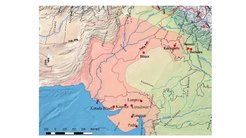
The Secondary Products Revolution model argues that the human exploitation of secondary animal products (milk, wool, and traction) was one of the crucial factors behind the development of complex societies during the Holocene. This research aims to test this model in the context of South Asia, one of the most populous parts of the world today. This project aims to understand human-animal interactions in this part of the world and how they may have shaped the social, political, and economic aspects of the Indus civilization, the earliest civilization of South Asia. This research aims to investigate how animals were raised, exchanged, and consumed, and then contextualize this information with the archaeological observation of cultural, political, and social changes.
It is now well established that animal herding and the utilization of domesticated animals for both dietary and non-dietary purposes were crucial for the Indus people. However, the role of pastoralism and increased consumption of secondary animal products in the development and expansion of this civilization is still understudied. In this project, using δ 13C of carbonate, δ 13C fingerprinting of amino acids, Strontium (Sr) isotope ratios of animal and human remains and δ 13CFA of ceramic residues, we aim to investigate the intensification of herding practices and of the consumption of primary and secondary animal products during pre-Indus, Indus, and post-Indus periods. The majority of the settlements under study are already dated; however, as part of this project, all of these settlements will be dated using AMS and Bayesian statistics, to develop a secure radiometric chronology.
The Archaeological and Ecological Applications of Faecal Biomarker Analysis
Project leader: Yiming Wang
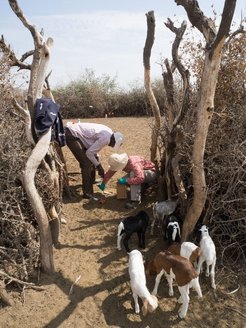
Human impact on the planet is often associated with European colonialism and the Industrial Revolution, but a too narrow focus on these recent changes overlooks how humans have transformed ecosystems in the past, especially in relation to our history of domesticating animals and cultivating the land. Searching for major thresholds of human impacts on earth systems in the past has been hindered by a lack of suitable markers of anthropogenic change that can be applied globally. This project seeks to develop a method in which to extract and measure human and animal faeces from archaeological and natural sediment accumulations to understand shifts in human presence and environmental impacts.
Faecal biomarker profiles specific to humans and different animals are being increasingly used to determine the presence of different taxa and their palaeodemography through time. Faeces contain unique biochemical tracers that may preserve for millennia under favourable conditions. However, to gain a better understanding of preservation processes, faecal biomarker transport, and landscape-level variation in faecal accumulation, it is essential to develop modern baselines for specific geographical, climatic, and anthropological contexts.
Much of this baseline work is yet to be done in an anthropological context, meaning that interpretations of such proxies in the archaeological record remain tentative. We are currently developing innovative baseline studies in a variety of climatic settings, in close collaboration with a number of diverse local communities, in order to determine how faecal biomarkers are preserved and presented across modern anthropogenic, particularly pastoral, landscapes.
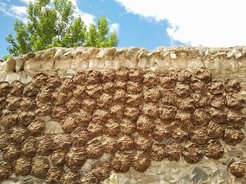
In tandem, we are also beginning to initiate a series of projects that investigate the demographics of wild and domesticated animals in response to human hunting and domestication using faecal biomarkers (bile acids and stanols) recovered from well-dated sediments. We will be applying these methodologies in areas where active archaeological research is being undertaken by the Department of Archaeology, and where we have solid existing contextual knowledge in relation to the presence of hunter-gatherers, pastoralists, and farmers in different regions through time. However, we will also expand our scope based on sample availability and the regional and temporal interests of members of the department at any given time.
Seabirds in a Changing World: Dietary Diversification and Forever Chemicals in Icelandic Guillemots (Project LOMVIA)
Project leader: Thomas Larsen
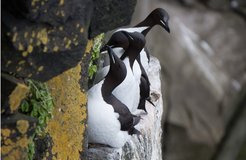
Climate change is having obvious and severe impacts in the Polar Regions. The Arctic is currently warming at more than double the rate of other parts of the globe, causing unprecedented change to the region’s ocean environment. The Arctic Ocean’s ecosystem is especially sensitive to warming because of its reliance on sea ice, from the algae that grow on its underside to large predatory mammals that hunt and live on its surface. In addition, top predators in Arctic ecosystems are increasingly affected by exposure to organic contaminants from anthropogenic sources.
Iceland's iconic seabird populations, the Brünnich's guillemot (Uria lomvia) and common guillemot (U. aalge), are declining. Both cliff-nesting species have similar lifestyles but differ in thermal preferences; Brünnich's guillemots thrive in Arctic conditions, while common guillemots favor warmer North Atlantic waters. The project LOMVIA studies investigates the dietary diversification of modern and historical populations of these two auk species in Iceland, as well as contaminant exposure in modern populations by leveraging biochemical methods and telemetry.
The research aims to: 1) examine interspecies competition for food resources between the two species in modern populations, 2) determine whether there was a higher degree of niche differentiation in historical seabird populations before global warming, and 3) assess how wintering and foraging strategies affect the bioaccumulation of PFASs in modern populations. By addressing these research questions, the study seeks to better understand the ecological impacts of climate change and anthropogenic contaminants on these seabirds, informing conservation and management efforts.
The project LOMVIA is jointly supported by Germany’s Federal Ministry of Education and Research (BMBF) and the UK’s Natural Environment Research Council (NERC).
Studying the Effects of Catastrophic Events on Marine Biogeochemical and Ecological Processes
Project leader: Yiming Wang
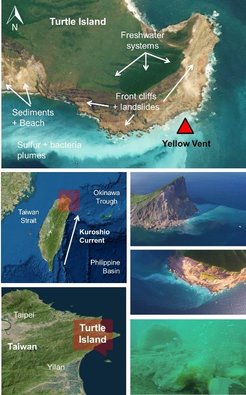
Extreme events caused by global change are increasingly affecting the ocean’s biogeochemical cycling and ecosystem functioning. However, our current understanding of how biogeochemical disruptions affect trophodynamics is limited because of the inherent challenges of studying food web responses to rapid habitat disturbances. In this project, we seized a unique opportunity to understand how specialists and generalists in a hydrothermal vent area respond and adapt to drastic biogeochemical disruptions. In 2016, the shallow hydrothermal vents at Kueishantao (KST) Island in East China Sea were hit by the two consecutive extreme events, an earthquake and a typhoon, causing a near vent shutdown for two years.
By using multiple geochemical tracers, we aim to conduct the first studies of temporal variability of the vent system, its responses to large geophysical and meteorological perturbations, and the effects on local biogeochemical and ecological processes. We also use stable isotope (d13C, d 15N, d 34S) as well as compound specific isotope ratios of individual amino acids to understand benthic food web shifts after extreme disturbances. The KST catastrophic events are analogous to man-made perturbations on coastal and deep-sea ecosystems, e.g., by industry discharges, mineral mining, or seabed dredging. Hence, quantifying their impact on marine ecosystems might shed light on the management of such anthropogenic perturbations.
Paleoclimate and Environment Changes in Tropic Monsoon Regions
Project leader: Yiming Wang
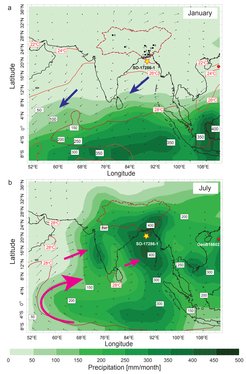
Addressing and anticipating future tropical monsoon changes under continuing global warming is of critical importance for the food security and socioeconomic well-being of 40% of the world’s population. Despite the far-reaching consequences, predicting tropical monsoon behavior under climate warming scenarios remains a key challenge for both global and regional climate models. This knowledge gap limits our understanding of the extent to which ISM intensity responds to rapidly changing climatic factors—such as rising sea surface temperature (SST), elevated atmospheric greenhouse gas (GHG) concentrations, changing vegetation cover, and decreasing ice sheets and sea ice cover—and their interactive dynamics in a warming climate.
We use compound specific stable isotope analyses of terrestrial biomarkers, namely leaf wax n-alkanes from marine sediments, to reconstruct changes in monsoon rainfall and vegetation in East Africa and South Asia. In addition, we also employ a suite of inorganic and organic proxies, which include foraminifera Mg/Ca ratio and d18O, and alkenone unsaturation index UK’37 to reconstruct past oceanographic conditions (e.g. sea surface temperature and salinity changes) in the Indian Ocean, which exert important influence on the adjacent continental hydroclimate. Besides generating new climate records, we have also collaborated with climate modelers to gain a deeper understanding of the mechanisms controlling climatic and oceanographic conditions. These paleoclimate reconstructions also provide regional climatic and environmental context for the information relating to demography and human social changes.
Human History on the Island of Madagascar
Project leader: Sean Hixon
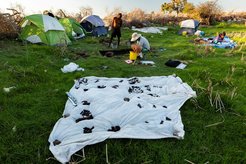
Madagascar, a large island sitting off the southeastern coast of the African continent, is a critical location for exploring past human migrations, adaptations to climate change, and anthropogenic influences on the environment. Today, the country faces some of the most severe threats in terms of species extinctions, habitat degradation, and economic stability anywhere in the world.
While much is still unclear, it now seems that humans arrived to Madagascar from various places in the past, with early arrivals from Africa being joined by seafaring populations with links as far off as southeast Asia. This diverse history of occupation has resulted in a rich linguistic and cultural heritage, as well as the arrival of different forms of land use and species.
This project uses combinations of field research (e.g., survey, excavation, sediment coring, and modern plant and animal specimen collection) and laboratory analysis (e.g., microfossil inventories and chemical analyses of plants and bones) to investigate human history on the island of Madagascar, including the following longstanding questions:
- When did humans arrive on Madagascar? How did different pulses of arrival vary in terms of their material culture and economic strategies?
- What forms of land use and which species did different groups of humans bring with them?
- How did different human groups, from hunter-gatherers to herders, from village dweller to town residents, respond to climate changes documented over the course of the Holocene?
- How did different human groups, in turn, impact the environments of Madagascar? How have these activities left legacies for communities living in the region today?
The project ties together a diversity of laboratories within the Department of Archaeology and beyond and involves close cooperation with Malagasy collaborators in the context of fieldwork and policy implications.
Stable Isotope Ratios of Amino Acids as Proxies for Trophic Position and Dietary Sources
Project leader: Thomas Larsen
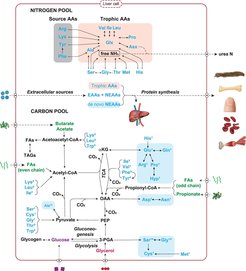
Understanding the diets of hominids and fauna, and the environments in which they lived, has long been a goal of paleoanthropological and archaeological research. While conventional methods such as examination of past plant and animal remains and bulk stable isotope analysis of archaeological tissue have yielded important insights into past diets, the dietary interpretations associated with these methods are sometimes uncertain. These uncertainties can in part be overcome with stable isotope analysis of single amino acids, the building blocks of proteins. Research has shown that their carbon and nitrogen stable isotope ratios can inform of trophic level and dietary sources independent of environmental conditions. Amino acids are valuable dietary markers because each of them has unique metabolic functions and properties. The multitude of data derived from amino acids can therefore be placed into statistical models to explore new resolution of food sources.
While the strengths of applying stable isotope ratios of amino acids for palaeodietary reconstruction are compelling, we are cognisant of the methodological challenges and interpretive knowledge gaps associated with this method. For this reason, our group takes an active interest in understanding how factors such as food preparation, digestive and metabolic processes, and diet quality affect isotope ratios of amino acids. We are also committed to making the method less cost prohibitive and improving data comparability across labs. To learn more about these topics, read our recently published guide on how best to use stable isotope ratios of amino acids: https://doi.org/10.1093/biosci/biac028







